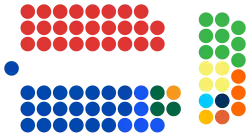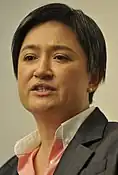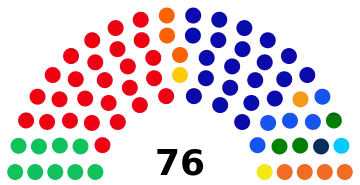| ||||||||||||||||||||||||||||||||||||||||||||||||||||||||||||||||||||||||||||||||||||||||||||||||||||||||||||||||||||||||||||||||||
All 76 seats in the Australian Senate 39 seats needed for a majority | ||||||||||||||||||||||||||||||||||||||||||||||||||||||||||||||||||||||||||||||||||||||||||||||||||||||||||||||||||||||||||||||||||
|---|---|---|---|---|---|---|---|---|---|---|---|---|---|---|---|---|---|---|---|---|---|---|---|---|---|---|---|---|---|---|---|---|---|---|---|---|---|---|---|---|---|---|---|---|---|---|---|---|---|---|---|---|---|---|---|---|---|---|---|---|---|---|---|---|---|---|---|---|---|---|---|---|---|---|---|---|---|---|---|---|---|---|---|---|---|---|---|---|---|---|---|---|---|---|---|---|---|---|---|---|---|---|---|---|---|---|---|---|---|---|---|---|---|---|---|---|---|---|---|---|---|---|---|---|---|---|---|---|---|---|
| ||||||||||||||||||||||||||||||||||||||||||||||||||||||||||||||||||||||||||||||||||||||||||||||||||||||||||||||||||||||||||||||||||
 Government (30) Coalition | ||||||||||||||||||||||||||||||||||||||||||||||||||||||||||||||||||||||||||||||||||||||||||||||||||||||||||||||||||||||||||||||||||
| ||||||||||||||||||||||||||||||||||||||||||||||||||||||||||||||||||||||||||||||||||||||||||||||||||||||||||||||||||||||||||||||||||
2016 Australian federal election |
|---|
|
| National results |
| State and territory results |
|
|
The 2016 Australian federal election in the Senate was part of a double dissolution election held on Saturday 2 July to elect all 226 members of the 45th Parliament of Australia, after an extended eight-week official campaign period. It was the first double dissolution election since the 1987 election and the first under a new voting system for the Senate that replaced group voting tickets with optional preferential voting.
The final outcome in the 76-seat Australian Senate took over four weeks to complete despite significant voting changes. Earlier in 2016, legislation changed the Senate voting system from a full-preference single transferable vote with group voting tickets to an optional-preferential single transferable vote.[1] The final Senate result was announced on 4 August: Liberal/National Coalition 30 seats (−3), Labor 26 seats (+1), Greens 9 seats (−1), One Nation 4 seats (+4) and Nick Xenophon Team 3 seats (+2). Former broadcaster and founder of the Justice Party Derryn Hinch, won a seat, while Jacqui Lambie, Liberal Democrat David Leyonhjelm and Family First's Bob Day retained their seats. The number of crossbenchers increased by two to a record 20. The Liberal/National Coalition will require at least nine additional votes to reach a Senate majority, an increase of three.[2][3][4]
A number of initially-elected senators were declared ineligible a result of the 2017–18 Australian parliamentary eligibility crisis, and replaced after recounts.
Terms of senators
The two major parties negotiated to allocate a six-year term to the first elected six of twelve senators in each state, while the last six received a three-year term. This was consistent with the Senate practice on all seven previous occasions.[5] In 1983 the Joint Select Committee on Electoral Reform had unanimously recommended an alternative "recount" method to reflect proportional representation,[6] and the Commonwealth Electoral Act provides for a recount on that basis.[7] This alternative method had been supported by both Labor and the Coalition in two separate, identical, bipartisan senate resolutions, passed in 1998 and 2010.[8][5][9] By not adhering to their previous resolutions, Labor and the Coalition each gained one senate seat from 2019.[10][11][12][13][14][15]
Australia
The final Senate result was announced on 4 August. The incumbent Liberal/National Coalition government won 30 seats, a net loss of three − the Coalition lost four Senators, one each from New South Wales, Queensland, Western Australia and South Australia, but gained a Senator in Victoria. The Labor opposition won 26 seats, a gain of one − a Senator in Western Australia. The number of crossbenchers increased by two to a record 20. The Liberal/National Coalition would require at least nine additional votes to reach a Senate majority, an increase of three.[2][3][4][16]

| Party | Votes | % | Swing | Seats won | Change | ||
|---|---|---|---|---|---|---|---|
| Liberal–National Coalition | 4,868,246 | 35.18 | –1.32 | 30 | |||
| Liberal/National joint ticket | 2,769,426 | 20.01 | −1.16 | 10 | |||
| Liberal | 1,066,579 | 7.71 | +0.77 | 14 | |||
| Liberal National | 960,467 | 6.94 | −1.16 | 5 | |||
| Country Liberal | 37,156 | 0.27 | −0.05 | 1 | |||
| National (WA) | 34,618 | 0.25 | −0.06 | 0 | |||
| Labor | 4,123,084 | 29.79 | +0.16 | 26 | |||
| Greens | 1,197,657 | 8.65 | −0.58 | 9 | |||
| One Nation | 593,013 | 4.29 | +3.76 | 4 | |||
| Xenophon Team | 456,369 | 3.30 | +1.37 | 3 | |||
| Liberal Democrats | 298,915 | 2.16 | –1.59 | 1 | |||
| Justice | 266,607 | 1.93 | +1.93 | 1 | |||
| Family First | 191,112 | 1.38 | +0.26 | 1 | |||
| Democratic Labour | 94,510 | 0.68 | –0.18 | 0 | |||
| Lambie Network | 69,074 | 0.50 | +0.50 | 1 | |||
| Motoring Enthusiasts | 53,232 | 0.38 | –0.12 | 0 | |||
| Palmer United | 26,210 | 0.19 | –5.42 | 0 | |||
| Total | 13,838,900 | 76 | |||||
| Invalid/blank votes | 567,806 | 3.94 | +1.01 | ||||
| Registered voters/turnout | 15,671,551 | 91.93 | –1.52 | ||||
| Source: Federal Election 2016 | |||||||
New South Wales
|
| ||||||||||||||||||||||||||||||||||||||||||||||||||||||||||||||||||||||||||||||||||||||||||||||||||||||||||||||||||||||||||||||||||||||||||||||||||||||||||||||||||||||||||||||||||||||||||||||||||||||||||||||||||||||||||||||||||||||||||||||||||||||||||||||||||||||||||||||||||||||||||||||||||||||||||||||||||||||||||||||||||||||||||||||
Victoria
|
| ||||||||||||||||||||||||||||||||||||||||||||||||||||||||||||||||||||||||||||||||||||||||||||||||||||||||||||||||||||||||||||||||||||||||||||||||||||||||||||||||||||||||||||||||||||||||||||||||||||||||||||||||||||||||||||||||||||||||||||||||||||||||||||||||||||||||||||||||||||||||||||||||||||||||||||||||||||||||||||
Queensland
|
| ||||||||||||||||||||||||||||||||||||||||||||||||||||||||||||||||||||||||||||||||||||||||||||||||||||||||||||||||||||||||||||||||||||||||||||||||||||||||||||||||||||||||||||||||||||||||||||||||||||||||||||||||||||||||||||||||||||||||||||||||||||||||||||||||||||||||||||||||||||||||||||||||||||||||||||||||||||||||||||
Western Australia
|
| ||||||||||||||||||||||||||||||||||||||||||||||||||||||||||||||||||||||||||||||||||||||||||||||||||||||||||||||||||||||||||||||||||||||||||||||||||||||||||||||||||||||||||||||||||||||||||||||||||||||||||||||||||||||||||||||||||||||||||||||||||||||||||
South Australia
|
| ||||||||||||||||||||||||||||||||||||||||||||||||||||||||||||||||||||||||||||||||||||||||||||||||||||||||||||||||||||||||||||||||||||||||||||||||||||||||||||||||||||||||||||||||||||||||||||||||||||||||||||||||||||||||||||||||||
Tasmania
|
| ||||||||||||||||||||||||||||||||||||||||||||||||||||||||||||||||||||||||||||||||||||||||||||||||||||||||||||||||||||||||||||||||||||||||||||||||||||||||||||||||||||||||||||||||||||||||||||||||||||||||||||||||||||||
Territories
Australian Capital Territory
|
| ||||||||||||||||||||||||||||||||||||||||||||||||||||||||||||||||||||||||||||||||||||||||||||||||||||||||||||
Northern Territory
|
| ||||||||||||||||||||||||||||||||||||||||||||||||||||||||||||||||||||||||||||||||||||||||||
Notes
- ↑ Brandis was the Leader of the Government in the Senate, whereas the leader of the Coalition in the Australian House of Representatives was Prime Minister Malcolm Turnbull.
- ↑ Wong was the Leader of the Opposition in the Senate, whereas the leader of the Labor Party in the Australian House of Representatives was Opposition Leader Bill Shorten.
- ↑ 3 LNP Senators sit in the Liberal party room and 2 in the National party room
- ↑ Sits in National party room
- 1 2 Nash was declared to be ineligible by the Court of Disputed Returns because she was a dual citizen of the United Kingdom.[18] A special recount resulted in Jim Molan being declared to have been elected.
- 1 2 Roberts was declared to be ineligible by the Court of Disputed Returns because he was a dual citizen of the United Kingdom.[18] A special recount determined that Fraser Anning was elected instead.
- 1 2 Waters resigned on 18 July 2017 because she was a dual citizen of Canada. The Court of Disputed Returns declared she was ineligible to be elected.[18] A special recount declared Andrew Bartlett had been elected instead.
- 1 2 Ludlam resigned on 14 July 2017 because he was a dual citizen of New Zealand. The Court of Disputed Returns declared he was ineligible to be elected.[18] A special recount led to Steele-John being declared to have been elected instead.
- 1 2 Culleton was found ineligible by the Court of Disputed Returns.[19] A special recount led to Georgiou being declared to have been elected on 10 March 2017.[20]
- 1 2 Kakoschke-Moore resigned on 22 November 2017 after learning she was a British citizen by descent. The Court of Disputed Returns declared she had been ineligible to be elected on 13 February 2018.[21] A special recount determined that Tim Storer was elected instead.
- 1 2 Day was found ineligible by the Court of Disputed Returns.[22] A special recount led to Gichuhi being declared to have been elected on 19 April 2017.[23]
- ↑ In 2016, Lisa Singh was demoted to sixth position on the Labor Party's Tasmanian Senate ticket behind Senator Catryna Bilyk and union secretary John Short.[24] A quota in Tasmania was 26,090 votes with Singh receiving 20,741 below-the-line votes: enough to overturn the party’s ticket order. She was the 10th senator elected for Tasmania, ahead of Catryna Bilyk (elected 11th), with John Short missing out.[25]
- 1 2 Parry resigned on 1 November 2017 because he was a dual citizen of the United Kingdom.[26] A special recount determined that Colbeck was elected instead.
- 1 2 Lambie resigned on 14 November 2017 because she was a dual citizen of the United Kingdom. The Court of Disputed Returns declared she had been ineligible to be elected on 9 February 2018. A special recount determined that Martin was elected instead.
References
- ↑ Nicole Hasham (3 July 2016). "Election 2016 results: Senate count throws up a wild mix as One Nation, Fred Nile, Liberal Democrats vie for seats". news.com.au. Retrieved 3 July 2016.
- 1 2 "AEC". Twitter. Retrieved 11 August 2016.
- 1 2 "Federal Election 2016: Senate Results". Australia Votes. Australian Broadcasting Corporation. 3 July 2016. Retrieved 4 July 2016.
- 1 2 "Senate photo finishes". Blogs.crikey.com.au. 12 July 2016. Retrieved 30 July 2016.
- 1 2 "Division of the Senate following simultaneous general elections". Odgers' Australian Senate Practice (14th ed.). Parliament of Australia. Retrieved 28 March 2017.
- ↑ Joint Select Committee on Electoral Reform (13 September 1983). "First report - electoral reform" (PDF). Parliament of Australia. pp. 66–7.
- ↑ Commonwealth Electoral Act 1918 (Cth) s 282 Re-count of Senate votes to determine order of election in other circumstances.
- ↑ Green, A (25 April 2016). "How long and short terms are allocated after a double dissolution". ABC.net.au.
- ↑ "Double dissolution election: implications for the Senate". Parliament of Australia. 29 January 2016.
- ↑ "Election 2016: Pauline Hanson secures six-year Senate term, Derryn Hinch has three years until re-election". ABC News. 12 August 2016. Retrieved 16 April 2019.
- ↑ Senate terms: Derryn Hinch and Greens' Lee Rhiannon given three years - The Guardian 12 August 2016
- ↑ ALP-LNP deal to force senators back to poll in three years: The Australian 13 August 2016
- ↑ Coalition and Labor team up to clear out crossbench senators in 2019: SMH 12 August 2016
- ↑ "Coalition flags first elected Senate plan: Sky News 12 August 2016". Archived from the original on 13 August 2016. Retrieved 12 August 2016.
- ↑ Cormann raises ‘first elected’ plan to halve Senate terms for crossbenchers: The Australian 12 December 2016
- ↑ "2016 Federal Election: First preferences by Senate group". Australian Electoral Commission. 9 August 2016. Retrieved 10 June 2022.
- ↑ Barber, Stephen (7 April 2017). "Federal Election 2016" (PDF). Research Paper 2016–17. Parliamentary Library. ISSN 2203-5249.
- ↑ Re Culleton (No 2) [2017] HCA 4. "Judgment summary" (PDF). High Court. 3 February 2017.
- ↑ "Senator Peter Georgiou". Parliament of Australia. Retrieved 5 April 2017.
- ↑ Byrne, Elizabeth; Doran, Matthew (13 February 2018). "High Court rules former NXT senator cannot replace herself, Tim Storer likely to win recount". ABC News. Retrieved 16 February 2018.
- ↑ Re Day [No 2] [2017] HCA 14, "Judgment summary" (PDF). High Court of Australia.
- ↑ "Senator Lucy Gichuhi". Parliament of Australia. Retrieved 5 November 2017.
- ↑ "Labor unveils Senate candidates with Lisa Singh relegated to unwinnable spot". ABC News. 12 May 2016. Retrieved 8 July 2016.
- ↑ "Lisa Singh's success rewrites history as Greens Nick McKim snares final Tasmanian Senate seat". The Mercury. 27 July 2016.
- ↑ Remeikis, Amy (1 November 2017). "Liberal Stephen Parry to resign over dual British citizenship". The Guardian. Retrieved 1 November 2017.



_(cropped).jpg.webp)

.png.webp)

_(cropped).png.webp)

